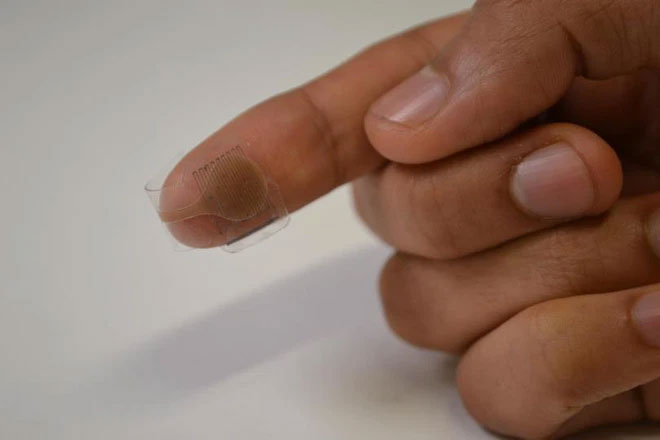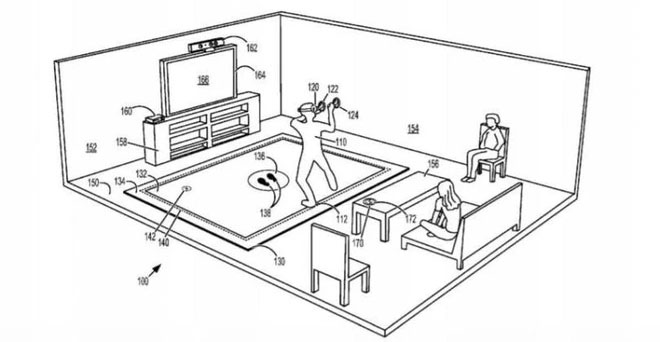According to a research report published in the journal Soft Robotics, scientists at the École Polytechnique Fédérale de Lausanne (EPFL) in Switzerland have developed a skin-like material that can be used to create wearable fabrics that simulate touch. The research team believes that this sensory material provides a more realistic sensation than the widely used haptic feedback technology.
With a lengthy name, “closed-loop haptic feedback control through self-sensing soft skin actuated by pneumatic pressure,” this artificial skin is only 500 nanometers thick, wrapping around the body like a super-thin layer of clothing.
The artificial skin can make virtual reality environments more realistic than ever.
In simple terms, this “skin” generates pressure through a membrane inflated by pneumatic air, simulating a more realistic touch sensation than current haptic feedback technology, which uses vibrations to mimic the feeling of touch.

This artificial skin simulates touch sensations more realistically than current haptic feedback technology.
By pushing pneumatic air into this thin skin, the research team can create various levels of pressure and frequency; continuously pumping and pushing air allows the thin membrane to vibrate at different intensities. On the surface of the material is a sensor filled with electrodes that can track changes on the skin, sending data to a tiny processor that can regulate the feedback sensation. This innovative material also possesses good stretchability, allowing it to cover a significant area of skin.
“This is the first time we have developed a thin artificial skin that contains both sensors and actuators,” said Harshal Sonar, the study’s author, to the press. “It gives us closed-loop control, meaning we can regulate the sensations that touch provides to the user. This will be a useful application for wearable devices.”
“The next step will be to develop a prototype device that applies this technology for medical facilities as well as for augmented reality and virtual reality technologies,” researcher Sonar added. “The prototype will be involved in brain research.”
Potential to Make the Metaverse More Realistic Than Ever
There is another application for this unique artificial skin, which is to help users immerse themselves more deeply in the metaverse. For a long time, science fiction works have envisioned technologies that allow users to feel 3D objects in virtual worlds. Haptic simulation devices like the aforementioned artificial skin will bring “fiction” closer to “reality” than ever before.

This skin helps users immerse themselves more deeply in the metaverse.
According to researchers at EPFL, the haptic feedback provided by the artificial skin has the potential to adapt to the user’s movements in real-time. This means that users of virtual reality technology, or those stepping into the virtual world of the metaverse, can interact with virtual objects and instantly receive realistic sensations.
3D modeled items will emit special signal streams, and the artificial skin will receive these signals, simulating them to transmit to the user’s skin. Thus, in addition to wearing a VR headset to see the virtual world, users will also be able to wear gloves to feel the virtual world with their sense of touch.
A “Magic Carpet” for Locating Players in Virtual Environments
At the end of 2019, Microsoft registered a patent to develop a unique virtual reality carpet. Positioned under the player’s feet, it will track the user’s movements and enhance the depth of the virtual world.
According to Variety, the augmented reality system will consist of three main elements: an optical sensor, a computing system, and a special carpet. The sensor will monitor the user’s movements in 3D space, while the carpet will accurately determine the user’s position.

Microsoft’s virtual reality carpet.
This system from Microsoft can create unique experiences based on user activities, making the experience within the virtual world more accurate and closer to reality than ever before.
The virtual reality technology community is being “pampered” immensely. New technologies, new devices, and even new concepts – such as the metaverse technology that has been promoted for some time – are all designed to create the most realistic virtual environment possible.
Within the metaverse, a virtual universe filled with realistic elements, users can unleash their creativity and participate in unique activities that may not exist in the real world.
Leading tech companies are pursuing the novel concept of the metaverse. Facebook, NVIDIA, Epic Games, and Microsoft are all dedicating resources to research and explore new horizons. The metaverse, considered the next evolutionary step of the internet, will be a promised land filled with hope and opportunities.
A new revolution is on the horizon, and its success will be determined by time.


















































